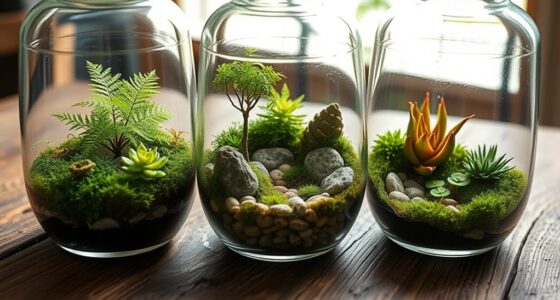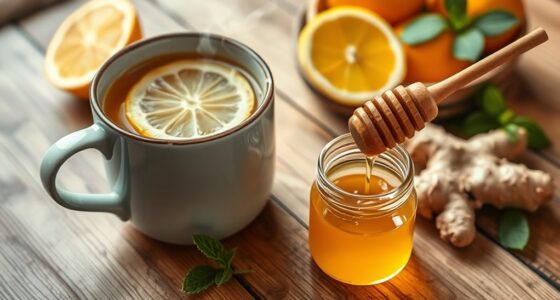For shiny, healthy hair, try herbal rinses like chamomile and lemon to brighten and boost glow, or rosemary and apple cider vinegar to strengthen and clarify your scalp. You can also use horsetail and nettle brews for added thickness, sage and green tea extracts to reduce buildup, and lavender with aloe vera for deep moisture. These natural recipes are easy to make at home and tailored to your hair’s needs—keep exploring to discover more tips and techniques.
Key Takeaways
- Use herbal infusions like chamomile and lemon to brighten hair and enhance natural shine.
- Incorporate rosemary and apple cider vinegar in rinses to boost scalp health and reflect light.
- Prepare nourishing brews with horsetail and nettle for thicker, shinier hair.
- Apply sage and green tea extracts weekly to reduce oiliness and improve hair radiance.
- Hydrate and soften hair with lavender and aloe vera rinses for a shiny, healthy glow.
Brightening Chamomile and Lemon Rinse

If you want to enhance your hair’s natural brightness, a chamomile and lemon rinse is an excellent choice. This natural treatment boosts hair color enhancement by highlighting warm tones and creating a radiant shine. Using herbal infusion techniques, you steep dried chamomile flowers and lemon slices in hot water, allowing the ingredients to release their beneficial properties. Once cooled, strain the mixture and apply it as a final rinse after shampooing. The gentle acids in lemon help brighten dull hair, while chamomile soothes the scalp and enhances shine. Regular use can bring out subtle golden hues and improve overall hair vibrancy. Incorporating herbal infusion techniques can maximize the extraction of beneficial compounds from the ingredients. This simple, natural method is safe and effective for maintaining luminous, healthy-looking hair.
Nourishing Rosemary and Apple Cider Vinegar Wash
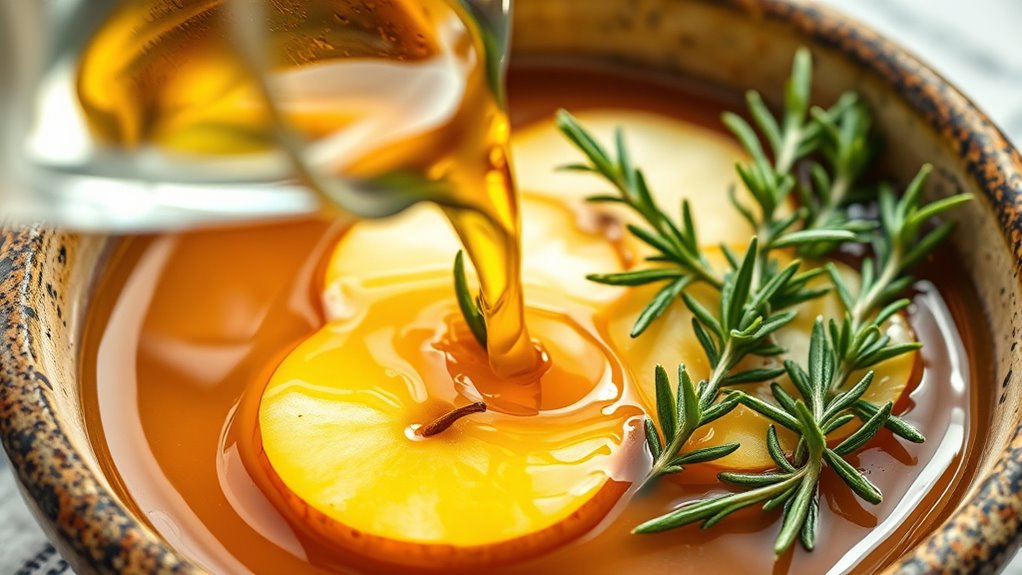
To strengthen your hair and restore its natural shine, try a nourishing rosemary and apple cider vinegar wash. Rosemary boosts hair growth by stimulating circulation to the scalp, while apple cider vinegar helps balance scalp pH, promoting overall scalp health. This rinse cleanses away residue, excess oil, and buildup that can weigh hair down. To make it, steep a handful of fresh rosemary in hot water for 20 minutes, then strain and add one cup of apple cider vinegar. After shampooing, pour the mixture over your hair, massage into your scalp, and rinse thoroughly. Regular use encourages healthier hair growth and leaves your hair shiny and vibrant. This simple, natural treatment supports scalp health and enhances your hair’s natural vigor. Additionally, using a contrast ratio with your hair care routine can help you better understand how different products impact your hair’s appearance and health.
Strengthening Horsetail and Nettle Brew

Using a strengthening horsetail and nettle brew can give your hair the essential nutrients it needs to grow thicker and healthier. During harvest season, you can collect fresh horsetail and nettle leaves, ensuring peak potency for your brew. After harvesting, dry the herbs properly and store them in airtight containers for herbal storage, so you have a supply year-round. To prepare the brew, steep equal parts of dried horsetail and nettle in hot water for about 30 minutes. Strain the mixture and let it cool before using. This herbal rinse strengthens hair strands, promotes growth, and adds shine. Regular use helps improve scalp health and reduces breakage, making it a natural addition to your hair care routine. Keep your herbs stored properly to maintain their potency over time.
Clarifying Sage and Green Tea Extract
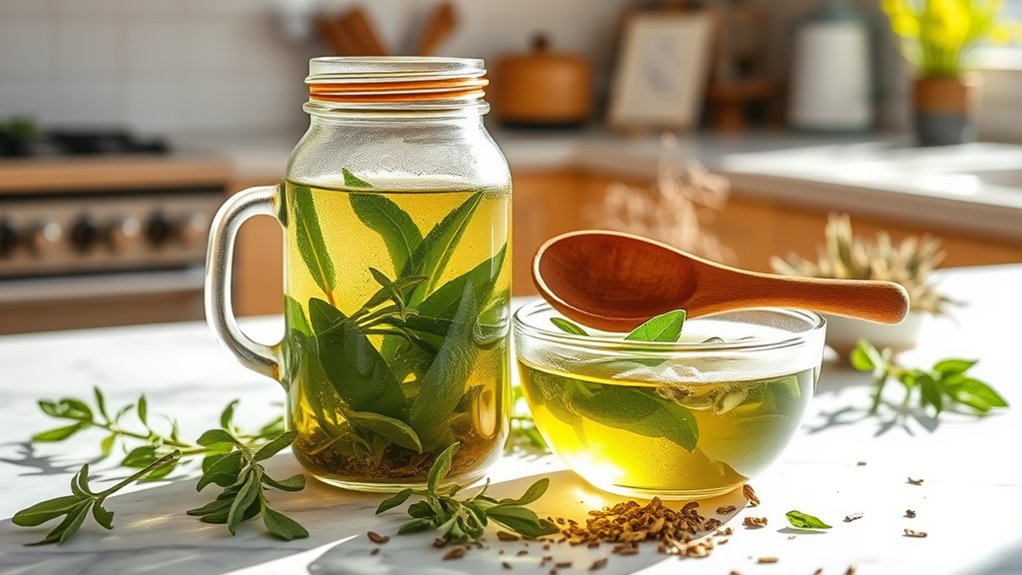
After strengthening your hair with horsetail and nettle, it’s equally important to clarify your scalp to prevent buildup and maintain healthy hair. Sage benefits include its ability to balance oil production and reduce dandruff, making it a great clarifying herb. Green tea antioxidants help fight free radicals, promoting scalp health and shine. To make a clarifying rinse, combine sage and green tea extracts for a natural detox. Here’s a quick comparison:
| Herb/Extract | Benefits | Key Components |
|---|---|---|
| Sage | Clarifies scalp, reduces oil buildup | Sage benefits, antimicrobial properties |
| Green Tea | Antioxidant-rich, fights free radicals | Green tea antioxidants |
Using these ingredients also aligns with ethical hacking principles of thorough assessment and targeted intervention to improve overall health. Use this rinse weekly to keep your scalp fresh and your hair shiny.
Moisturizing Lavender and Aloe Vera Solution
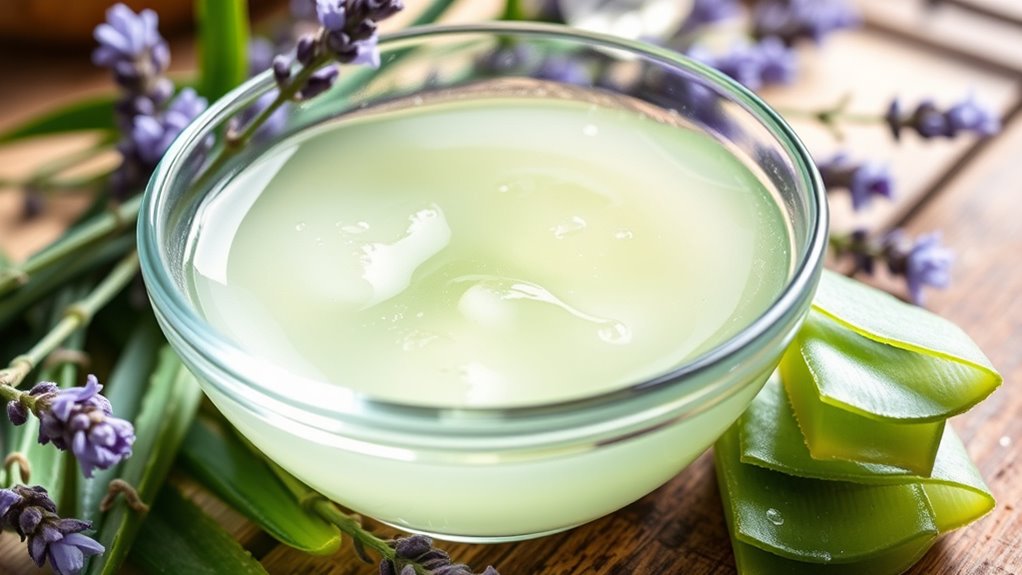
Moisturizing your scalp and hair is essential for maintaining softness and preventing dryness, especially if you use styling products frequently. To make a nourishing lavender and aloe vera solution, start with herbal infusion techniques—steep fresh or dried lavender flowers and aloe vera gel in hot water for at least 30 minutes. This process unblocks maximum herbal benefits. Automation in business can help streamline the infusion process, saving time and ensuring consistency. Before applying, test your hair porosity to determine how well your hair absorbs moisture; high porosity hair benefits from more frequent moisturizing, while low porosity needs gentler treatments. Once infused, strain and cool the liquid. Use it as a rinse after shampooing to hydrate and soothe your scalp, promoting shine and flexibility. This simple herbal infusion provides a natural moisture boost tailored to your hair’s needs.
Frequently Asked Questions
Can Herbal Hair Rinses Cause Allergic Reactions?
Herbal hair rinses can cause allergic reactions if you’re sensitive to certain natural ingredients. Your chemical sensitivities might lead to irritation or redness, especially if the ingredients aren’t tested for safety. To protect yourself, always do a patch test before using a new rinse. Remember, natural ingredient safety isn’t guaranteed for everyone, so listen to your body and discontinue use if you notice any adverse reactions.
How Often Should I Use Herbal Hair Rinses?
Did you know that over 60% of people find herbal rinses improve hair health? For ideal results, you should consider your hair type and scalp sensitivity when deciding on application frequency. Generally, using herbal rinses 1-2 times a week works well. Keep in mind, ingredient variations can affect how often you should apply, so adjust accordingly and monitor your hair’s response to find the best routine.
Are Herbal Rinses Suitable for All Hair Types?
Herbal rinses are generally suitable for most hair types, but hair type compatibility varies. You should consider the herbal ingredient variety to match your needs—oily hair might benefit from clarifying herbs like rosemary, while dry hair could prefer nourishing options like chamomile. Test small amounts first to see how your hair responds. Customizing herbal rinses guarantees they work well for your specific hair type and concerns.
Do Herbal Rinses Stain Light-Colored Hair?
Herbal rinses can sometimes stain light-colored hair, especially if they contain strong dyes like henna or indigo. While herbal dyeing is popular for adding subtle tones, it may affect hair color preservation and cause unwanted color shifts. If you have light hair, test the rinse on a small section first to prevent staining. Proper rinsing and choosing gentle herbs can help you enjoy benefits without risking discoloration.
How Long Does It Take to See Results?
When wondering how long it takes to see results, keep in mind that timeframe expectations vary depending on your hair type and the natural ingredient effects. Generally, you might notice improved shine and health within a few washes, typically around 2-4 weeks. Consistency is key; regular use allows the herbal rince to nourish your hair gradually, revealing the positive changes you’ve been aiming for.
Conclusion
So, there you have it—an arsenal of DIY herbal rinses to give your hair that “wow” shine. Who knew that herbs and a splash of vinegar could outshine store-bought products? Just remember, all those natural ingredients might not turn your hair into a mirror overnight, but at least you’ll have fun pretending you’re a hair care wizard. After all, who needs commercial magic when you’ve got herbs and a little patience?



